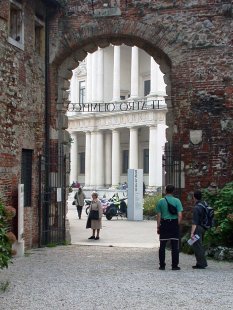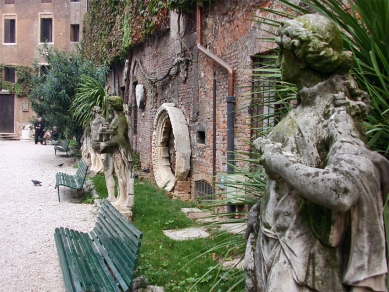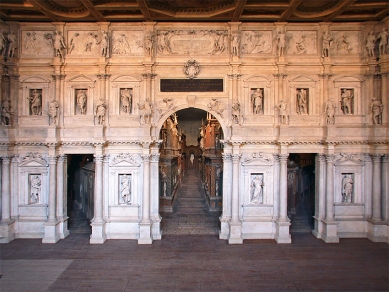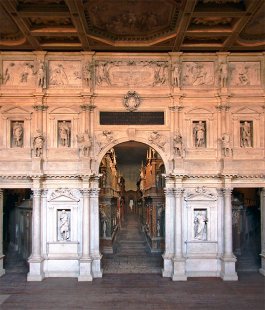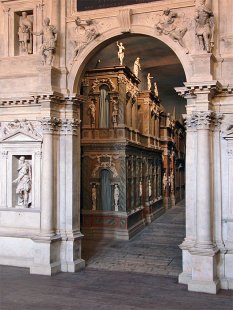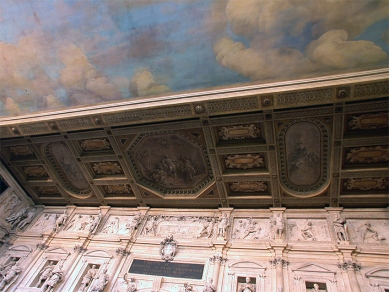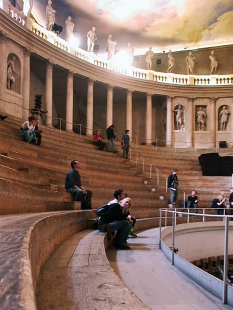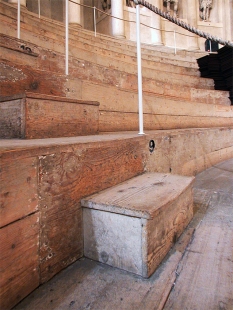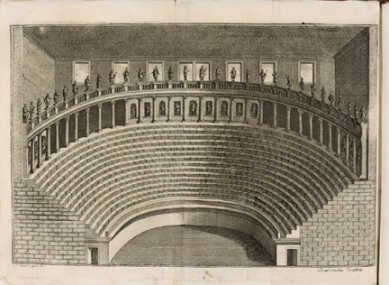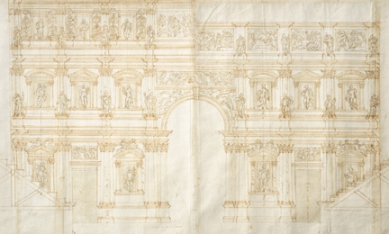
Odeon Theater

Teatro Olimpico is a theater located in the northern Italian city of Vicenza. It is the last work of Renaissance architect Andrea Palladio, which is generally considered the first covered theater of the modern age.
The project for the theater was commissioned to Palladio in 1579 by an institution called the Accademia Olimpica, which ordered it for the eastern part of the city. Construction began that year and was officially opened on March 3, 1585 – after the completion of the sets by Vicenza Scamozzi. These settings represent the only surviving example of a Renaissance stage; just like Teatro Olimpico, it is the oldest preserved Renaissance theater.
Together with other Palladian buildings in Vicenza, the theater has been included since 1994 in the complex of protected sites of the UNESCO World Cultural Heritage – as part of the ensemble "City of Vicenza and Palladio's villas in the Veneto region".
Teatro Olimpico is Palladio's last work and is one of his key masterpieces. The architect returned to his native city in 1579 and brought with him extensive records of classical theaters based on Vitruvius's treatise De architectura libri decem (Ten Books on Architecture) and further on personal observations from studying the ruins of Roman architecture (especially the theater of Berga in Vicenza).
Palladio, the founder of the Accademia Olimpica (established in 1555), had previously designed temporary scenic situations for various locations in the city. In 1579, the Academy obtained permission to build a permanent theater in the old medieval fortress Castello del Territorio, which before it definitively lost its use had served as a prison and munitions depot.
Palladio died in 1580, just six months after construction began. However, the work led by his son Silla could continue based on Palladio's sketches and plans. In 1584, the auditorium with the loggia and the stage was completed. Palladio left no elaborate design (only a rough sketch) for the stage sets, and thus another prominent Vicenzan architect, Vicenzo Scamozzi, was called for this task. Scamozzi is also the author of the spaces of the theater hall as well as the original entrance portal. With the help of seven corridors, designed similarly to the streets of Greek Thebes, the local stage introduces the idea of perspective into the Renaissance theater. The idea hidden behind the seven corridors is to offer each spectator a view of at least one of the streets. The false, illusory perspective provides an optical illusion of long streets in just a few meters of real space.
The theater was officially opened on March 3, 1585, with Sophocles' play Oedipus Rex. However, after several productions, it was practically abandoned. The wooden sets with plaster stucco, which were made for Oedipus Rex and were meant to represent the streets of Thebes, were never removed; despite bombing and other strokes of fate, they have miraculously survived to this day. The original lighting with glass oil lamps, designed by Scamozzi to enhance the illusion of space, was used only a few times due to high costs and fire hazards. However, it was used again in 1997 when Oedipus Rex was staged in the theater.
Today, Teatro Olimpico is used for theater and musical productions. However, the number of spectators is limited to 400 for preservation reasons. Performances are held in two seasons: classical performances in the fall and the festival Il Suono dell'Olimpico in the spring. No heating or air conditioning has been installed in the building, as it could damage the wooden structure. Every June, the venue is used for the graduation ceremony of students from the American Defense University based in Vicenza.
Kateřina Lopatová
The project for the theater was commissioned to Palladio in 1579 by an institution called the Accademia Olimpica, which ordered it for the eastern part of the city. Construction began that year and was officially opened on March 3, 1585 – after the completion of the sets by Vicenza Scamozzi. These settings represent the only surviving example of a Renaissance stage; just like Teatro Olimpico, it is the oldest preserved Renaissance theater.
Together with other Palladian buildings in Vicenza, the theater has been included since 1994 in the complex of protected sites of the UNESCO World Cultural Heritage – as part of the ensemble "City of Vicenza and Palladio's villas in the Veneto region".
Teatro Olimpico is Palladio's last work and is one of his key masterpieces. The architect returned to his native city in 1579 and brought with him extensive records of classical theaters based on Vitruvius's treatise De architectura libri decem (Ten Books on Architecture) and further on personal observations from studying the ruins of Roman architecture (especially the theater of Berga in Vicenza).
Palladio, the founder of the Accademia Olimpica (established in 1555), had previously designed temporary scenic situations for various locations in the city. In 1579, the Academy obtained permission to build a permanent theater in the old medieval fortress Castello del Territorio, which before it definitively lost its use had served as a prison and munitions depot.
Palladio died in 1580, just six months after construction began. However, the work led by his son Silla could continue based on Palladio's sketches and plans. In 1584, the auditorium with the loggia and the stage was completed. Palladio left no elaborate design (only a rough sketch) for the stage sets, and thus another prominent Vicenzan architect, Vicenzo Scamozzi, was called for this task. Scamozzi is also the author of the spaces of the theater hall as well as the original entrance portal. With the help of seven corridors, designed similarly to the streets of Greek Thebes, the local stage introduces the idea of perspective into the Renaissance theater. The idea hidden behind the seven corridors is to offer each spectator a view of at least one of the streets. The false, illusory perspective provides an optical illusion of long streets in just a few meters of real space.
The theater was officially opened on March 3, 1585, with Sophocles' play Oedipus Rex. However, after several productions, it was practically abandoned. The wooden sets with plaster stucco, which were made for Oedipus Rex and were meant to represent the streets of Thebes, were never removed; despite bombing and other strokes of fate, they have miraculously survived to this day. The original lighting with glass oil lamps, designed by Scamozzi to enhance the illusion of space, was used only a few times due to high costs and fire hazards. However, it was used again in 1997 when Oedipus Rex was staged in the theater.
Today, Teatro Olimpico is used for theater and musical productions. However, the number of spectators is limited to 400 for preservation reasons. Performances are held in two seasons: classical performances in the fall and the festival Il Suono dell'Olimpico in the spring. No heating or air conditioning has been installed in the building, as it could damage the wooden structure. Every June, the venue is used for the graduation ceremony of students from the American Defense University based in Vicenza.
Kateřina Lopatová
The English translation is powered by AI tool. Switch to Czech to view the original text source.
0 comments
add comment


